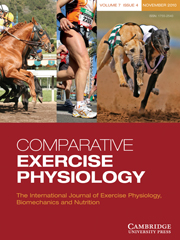Article contents
Neither age nor osteoarthritis is associated with synovial fluid antioxidant disturbance or depletion in the horse
Published online by Cambridge University Press: 22 October 2009
Abstract
Studies investigating the role of oxidative stress in both the ageing process and osteoarthritis (OA) in human beings are limited by the unavailability of samples from healthy subjects. OA occurs naturally in the horse and has been used as a model of human OA. The objective of this study was to determine the effect of ageing and OA on the non-enzymatic synovial fluid antioxidant status of the horse. The concentrations of ascorbic acid, dehydroascorbate (DHA, oxidized ascorbic acid), uric acid, glutathione, α-tocopherol and thiobarbituric acid reactive substances (TBARS) were determined in paired synovial fluid and plasma samples from 25 horses aged between 3 and 25 years. Osteoarthritic lesions were scored from 0 (healthy) to 4 (severe OA). Glutathione was not detectable in synovial fluid. Neither plasma nor synovial fluid antioxidant concentrations were affected by age. Ascorbic acid concentrations in plasma correlated strongly with those in synovial fluid from both healthy (P < 0.001) and diseased joints (P = 0.003). Synovial fluid concentrations of ascorbic acid and uric acid were not influenced by OA compared with healthy joints. However, the concentration of DHA was slightly, but significantly, elevated in synovial fluid from joints with severe OA (95% CI: [2.2, 11.8] μmol l− 1; P < 0.001). OA is associated with only a mild oxidative burden, which does not appear to overwhelm the synovial fluid antioxidant capacity. Consequently, antioxidant supplementation is unlikely to have a beneficial effect in the treatment of OA.
Keywords
Information
- Type
- Research Paper
- Information
- Copyright
- Copyright © Cambridge University Press 2009
Footnotes
Present address: School of Mathematics and Statistics, University of Plymouth, Drake Circus, Plymouth, Devon PL4 8AA, UK.
References
- 1
- Cited by

